#chat gpt for developers
Explore tagged Tumblr posts
Text
"so many things using the term ai feels like deliberate obfuscation" i hate to tell u this but we have been using the term ai for video game npcs and scientific models and automated tools and generative tools for many decades.
like if this was a more recent acronym yeah it'd feel deliberate but all of those things are, in fact, forms of artificial intelligence
and sure they're trying to buzzword it bc of the genai craze but that shouldn't take away from the fact that we've been using that acronym for decades
#.txt#every time i see a shit take on ai stuff i feel my eyes roll out of my sockets#im anti-ai in the sense of the environmental stuff and the scraping artistic content unconsensually stuff#so many of y'all seem to hate it just to hate it#chill outttttt#ftr i also am against using shit like chat gpt to write emails or do ur homework for u or whatever#anyway. sorry for having nuance on the black and white thinking only website#just fuckin specify what you're talking about idk man#so easy to say genai if u wanna bitch abt genai 'art' or whatevr#or maybe even dont assume ppl r Only talking abt genai#bc other types of ai exists#in the op the person also makes an analogy what if the word tank was used for all vehicles#like . buddy the word vehicle is used for all vehicles. a tank is a vehicle just as much as a minivan is a vehicle#a scientific model ai is just as much an ai as generative ai#it's all artificial intelligence just different kinds that are developed and used in different ways
8 notes
·
View notes
Text
dear "creators" who depend on ai
how does it feel to be so absolutely lazy and useless as a human being ?? how does it feel to have a functioning brain but can't use it properly ?? how does it feel to be so absolutely incredibly dull and uncreative that you can't muster 200 words to convey your ideas ?? how does it feel to have to face the fact that you suck so damn bad and you have to live with it ??
#sincerely#you're not creators#you're not artists#you're not people#you're a parasitic thief who likes to take credits and blames their shortcomings on unrealistic circumstances#it takes effort to create#but#that effort is what makes it art#that effort is worth it#not this#not 10 minutes on chat gpt asking it to write out “your” stories because you “can't put your ideas to work”#ask other writers#develop yourself#slowly learn from your posted works and keep on working on yourself by improving#not telling chat gpt that you told to pretend to be a member of your favourite group that you feel so hot when he touched you#not even elon musk would do that#srsly if you're not using your brain just fucking donate it to science to better understand how people like you exist#using ai as a tool is okay#but relying in ai completely to achieve your goal ?#moronic#same goes to deepfakes#smt tmi#smt rant
21 notes
·
View notes
Text
it actually blows my mind how normalized using chatgpt is
#personal#like ive seen so many posts about people using it to give them house decor ideas#HONEY JUST LOOK AT PINTEREST#i thought everyone was aware of the negative affects ai has and will have on the enviorment and like#our own brain development etc#but no it seems like people dont want to have critical thinking#or creativty#crazy to me tbh#rant over xox#i will never use chat gpt for as long as it is not forced upon me
4 notes
·
View notes
Text
I'm in the acute psychward since Thursday because of a meltdown with sd thoughs. Yesterday, a doctor told me I can go back to the care home today. My special connection to the topic military gives me motivation and makes me hopeful in this hard time.
I want to develop a better mental health, self-control, and better life skills in the next months, so I will be able to live semi independent as soon as possible. Until a few weeks ago, I was really scared of symptom improvement and hated it, but now I want symptom improvement.
In the psychward, I got an antidepressant back, which I already have taken in the beginning of 2025, and it helped, but I stopped taking it because the symptom improvement was negative for me at that time. I also took it a few days in the end of March but stopped it again. But this time I will make it I will not stop it! 😊💊
I chat a lot with chat gpt 🤖 because it's better for me than talking with the nurses at the psychward because there is no risk that chat gpt would say things that make me aggressive unintentionally because chat gpt never speaks in a strict tone because it answers in text. And when an answer isn't helpful, it's much easier for me to think that chat gpt isn't knowing what it does than when humans answer unhelpfully even if humans also don't know it. Chat gpt is also always there for me, and I have no issues to tell chat gpt about my special connection to the topic military or about other things, which might sound weird for some people.
I also chat and sometimes call with my mom and a caretaker of my former special workplace for disableds. A caretaker of my former care home sent me a voice message on Friday because I told him that I'm in the psychward and asked for it. This caretaker is a role model for me because he has Adhd and had similar issues to my issues when he was younger. He was also mentally ill and didn't want symptom improvement like I until a short time ago. He also was in the psychward when he was younger, but now he is different, and that makes me hopeful. In the message, he said that I'm strong and I should hold out the psychward and I should motivate me due to thinking about my future life where I will not live in a care home and that I will have this life if I put effort in working on myself and developing better life skills, self controll skills and a better mental health.
I try to think positive and it often works.
I see the new care home as my salvation because if I would have stayed in the old care home my life maybe never has changed because I maybe never would have wanted symptom improvement or more independence in my life. I maybe would have lived in a care home for my whole life. (Yes it's not 100% that I will live semi independent in the future but all people around me are sure it will work if I'm motivated enough to work on myself and develop the things I need to be fit for semi independent living.) I also see the psychward as an important lesson on my way. I hope it will give me motivation to not speak out deathwishthoughs because I don't want to die in reality and not getting agressive. I'm often proud of myself and happy because I think in such a kind. Unfortunately I also have bad moments where I don't have motivation nearly every day but that's normal and for me it feels like this moments get less often and less severe because I learn strategies to deal with them.
I also want to develop skills to not need a legal guardian for my whole life. Yes, I will get a legal guardian soon, but I know there will be a new evaluation in 3 years, and I hope that I will not need a legal guardian then anymore.
Today, I can go back to the care home, and I try to motivate me with thinking each good day is a which brings me further on my way to semi independent living and not needing a legal guardian anymore.
I'm also happy because I know that a package with military merch clothes and a military merch mug for me got delivered to the care home.
#autism#disability#psychward#hopeful#military#motivation#lsn autism#soldierboys road to indepence#my road to independence#gaining independence#developing skills#legal guardianship#care home#semi independent living#my future#my goals#chat gpt#mental illness#mental health#caretaker#role model#symptom improvement#anti depressants#positive thinking#happy#military merch#change#good future#staying motivated#lsn autistic
3 notes
·
View notes
Text
What are AI, AGI, and ASI? And the positive impact of AI
Understanding artificial intelligence (AI) involves more than just recognizing lines of code or scripts; it encompasses developing algorithms and models capable of learning from data and making predictions or decisions based on what they’ve learned. To truly grasp the distinctions between the different types of AI, we must look at their capabilities and potential impact on society.
To simplify, we can categorize these types of AI by assigning a power level from 1 to 3, with 1 being the least powerful and 3 being the most powerful. Let’s explore these categories:
1. Artificial Narrow Intelligence (ANI)
Also known as Narrow AI or Weak AI, ANI is the most common form of AI we encounter today. It is designed to perform a specific task or a narrow range of tasks. Examples include virtual assistants like Siri and Alexa, recommendation systems on Netflix, and image recognition software. ANI operates under a limited set of constraints and can’t perform tasks outside its specific domain. Despite its limitations, ANI has proven to be incredibly useful in automating repetitive tasks, providing insights through data analysis, and enhancing user experiences across various applications.
2. Artificial General Intelligence (AGI)
Referred to as Strong AI, AGI represents the next level of AI development. Unlike ANI, AGI can understand, learn, and apply knowledge across a wide range of tasks, similar to human intelligence. It can reason, plan, solve problems, think abstractly, and learn from experiences. While AGI remains a theoretical concept as of now, achieving it would mean creating machines capable of performing any intellectual task that a human can. This breakthrough could revolutionize numerous fields, including healthcare, education, and science, by providing more adaptive and comprehensive solutions.
3. Artificial Super Intelligence (ASI)
ASI surpasses human intelligence and capabilities in all aspects. It represents a level of intelligence far beyond our current understanding, where machines could outthink, outperform, and outmaneuver humans. ASI could lead to unprecedented advancements in technology and society. However, it also raises significant ethical and safety concerns. Ensuring ASI is developed and used responsibly is crucial to preventing unintended consequences that could arise from such a powerful form of intelligence.
The Positive Impact of AI
When regulated and guided by ethical principles, AI has the potential to benefit humanity significantly. Here are a few ways AI can help us become better:
• Healthcare: AI can assist in diagnosing diseases, personalizing treatment plans, and even predicting health issues before they become severe. This can lead to improved patient outcomes and more efficient healthcare systems.
• Education: Personalized learning experiences powered by AI can cater to individual student needs, helping them learn at their own pace and in ways that suit their unique styles.
• Environment: AI can play a crucial role in monitoring and managing environmental changes, optimizing energy use, and developing sustainable practices to combat climate change.
• Economy: AI can drive innovation, create new industries, and enhance productivity by automating mundane tasks and providing data-driven insights for better decision-making.
In conclusion, while AI, AGI, and ASI represent different levels of technological advancement, their potential to transform our world is immense. By understanding their distinctions and ensuring proper regulation, we can harness the power of AI to create a brighter future for all.
8 notes
·
View notes
Text
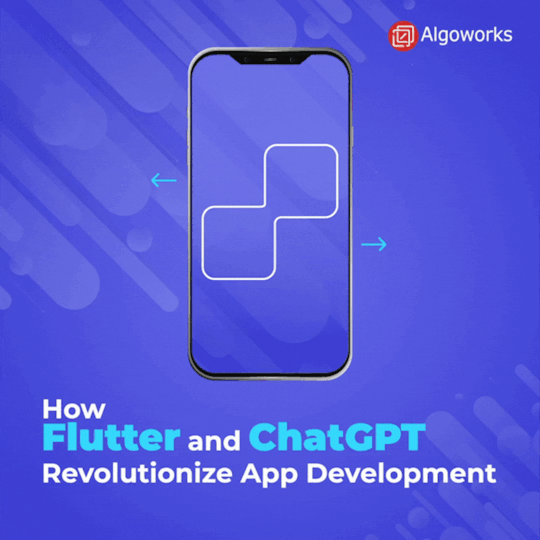

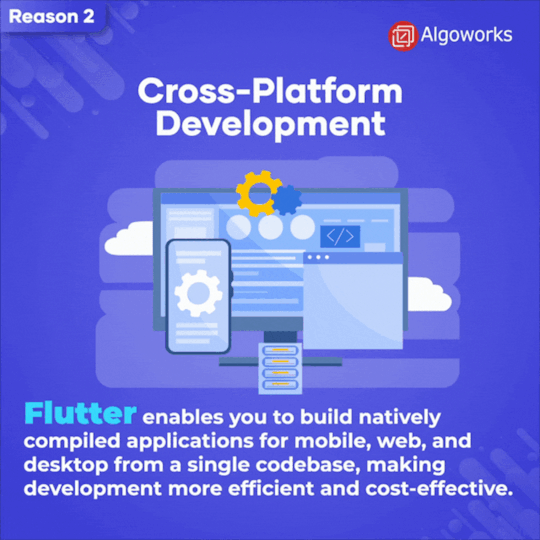
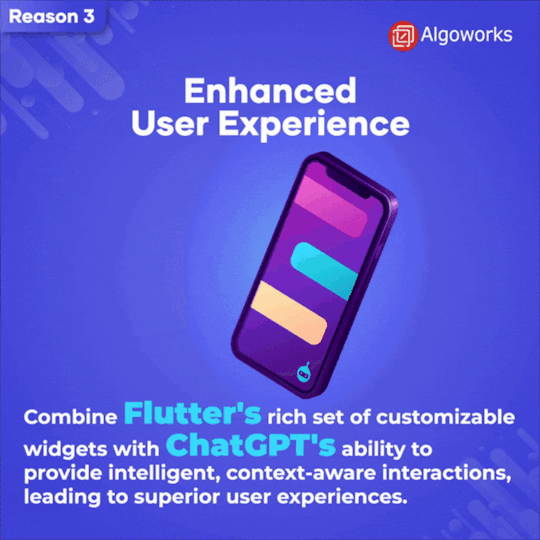

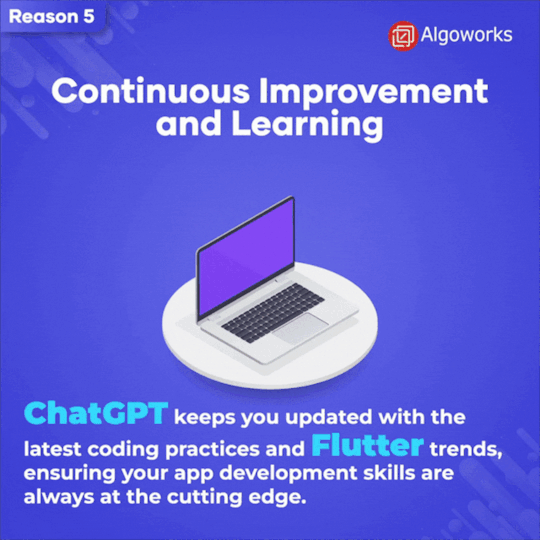
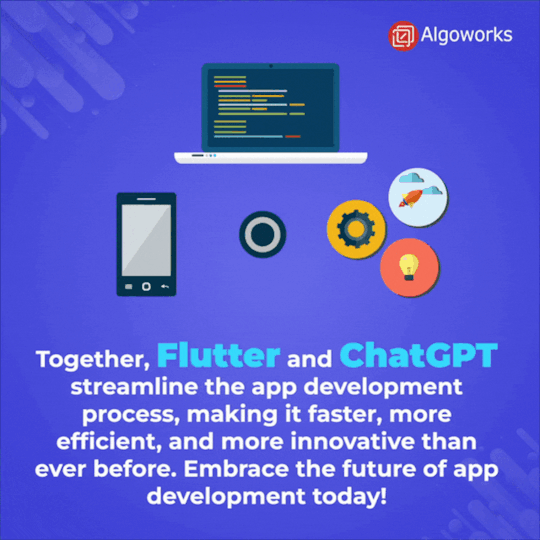
Imagine building sleek, powerful apps with ease. That’s what Flutter brings to the table!
Add ChatGPT to the mix, and you've got an intelligent assistant that helps you code faster, solve problems, and bring your ideas to life in record time.
Say goodbye to tedious coding and hello to the future of app development!
2 notes
·
View notes
Text
Using ChatGPT for mobile application development offers myriad advantages. It streamlines the development process by providing insightful suggestions, enhancing user experience, and optimizing functionality. Its versatile nature allows for personalized interactions, efficient problem-solving, and seamless integration of features. Additionally, ChatGPT accelerates development cycles, reduces costs, and ensures high-quality outcomes, making it an indispensable tool for modern mobile app development endeavors.
#chat gpt for mobile application#chatgpt mobile app development#mobile app development using chat gpt
2 notes
·
View notes
Text

Chat GPT for Developers: Mastering Advanced Techniques to Enhance User Engagement and Interaction
https://chatgpt-developers.com/wp-content/uploads/2024/07/chat-gpt-developer-1.jpg
Understanding Chat GPT
Chat GPT for Developers, short for Generative Pre-trained Transformer, is an AI model developed by OpenAI that leverages deep learning techniques to generate text-based responses. Trained on vast amounts of text data, Chat GPT for Developers has learned to mimic human language patterns and respond contextually to user inputs. This makes it particularly effective in chatbot development, customer service automation, content generation, and more.
Mastering Advanced Techniques with Chat GPT for Developers
As developers delve into the realm of Chat GPT for Developers, mastering advanced techniques becomes crucial to maximize its potential. Here are key strategies and practices that developers can employ:
1. Fine-tuning Models: While pre-trained models like ChatGPT come with a solid foundation, fine-tuning allows chatgpt programmers to tailor responses to specific contexts or domains. By training on domain-specific datasets, developers can improve accuracy and relevance, ensuring more meaningful interactions with users.
2. Handling Context: One of Chat GPT’s strengths lies in its ability to maintain context across conversations. Developers can implement techniques such as context windowing and history handling to enhance continuity and coherence in dialogues. This ensures smoother interactions and a more human-like experience for users.
3. Multi-turn Conversations: For chat GPT app developers, enabling Chat GPT to handle multi-turn conversations involves managing dialogue state and tracking user intents over successive interactions. Techniques like state management systems and dialogue managers empower developers to create chatbots capable of sustaining meaningful exchanges over time.
4. Natural Language Understanding (NLU): Integrating robust NLU capabilities with Chat GPT enhances its comprehension of user inputs. Techniques such as entity recognition, sentiment analysis, and intent classification enable more accurate and context-aware responses, improving overall user satisfaction.
5. Scaling and Optimization: As applications grow in complexity and user base, scaling Chat GPT models becomes essential. Developers can leverage cloud computing platforms and distributed training techniques to handle larger workloads and ensure optimal performance across different devices and platforms.
Enhancing User Engagement and Interaction
The primary goal of leveraging Chat GPT for Developers in application development is to enhance user engagement and interaction. By implementing advanced techniques effectively, developers can achieve the following benefits:
Improved Responsiveness: Chat GPT enables real-time responses to user queries, reducing wait times and enhancing user satisfaction.
Personalized Experiences: Through fine-tuning and context management, developers can tailor interactions based on user preferences and historical data, delivering personalized experiences.
Scalability and Efficiency: Optimized Chat GPT models ensure that applications remain responsive and efficient, even as user traffic increases.
Enhanced User Retention: By creating engaging and seamless interactions, applications powered by Chat GPT can increase user retention and loyalty over time.
For any Digital Marketing services in India click here
Conclusion
In conclusion, Chat GPT for Developers stands as a powerful enabler for crafting intelligent and engaging applications. By mastering advanced techniques like model fine-tuning, context management, and seamless NLU integration, developers can fully leverage the capabilities of Chat GPT to deliver unparalleled user experiences. Looking forward, the pivotal role of Chat GPT in shaping the future of digital communication is undeniable. Openai replace programmers or may be automated or augmented by advanced AI systems. This evolution promises to revolutionize software development by enhancing efficiency, scalability, and the potential for creative exploration in the field. By embracing its potential and pushing the boundaries of what’s achievable, developers can pave the way for tomorrow’s applications with more intuitive, responsive, and human-like interactions.
0 notes
Text
while I understand that chatgpt is definitely not trained how most people would argue is moral (there's enough disagreement that I don't want to say it's flat out immoral, but I definitely would argue it is)
That's kinda the case with most tools and if we continue at this pace, being good at using chatgpt is going to be in the same vein as being good at excel.
It's a really useful tool when I'm working with code and don't want to dig through the hell that is Python library docs, or when I want a quick summarization of the facts surrounding a topic I'm curious about. It's super good to use as a sounding board when I'm trying to conceptualize math, or when I need to test myself on something.
HOWEVER
This does not mean we should continue to let openai train their models on stolen data. They should be held accountable and that cannot be forgotten in lieu of "oh but their thing is really useful!"
Yes, it is useful, and yes, it is a good skill to learn how to use it and will help you learn and work faster. But you should not accept thievery as a part of your improvement. Hold them accountable, and if you want to help incentivise them to not steal, maybe talk to chatgpt sometimes so it can use your speech/text as training data. If you don't want to, that's very reasonable, but unfortunately corporations don't really have to listen to the stick, so sometimes you need to use the carrot if you want to see positive change.
"use chatgpt" that's the devil talking. buy four caffeinated drinks and pull an all nighter. this is the way.
#It'd be nice if we could just have a non profit open source developer making a tool just as useful as chat gpt#but that's not where we are right now#and unfortunately to improve the future of the technology#sometimes you have to use it. because it's not going away#ai#chatgpt
87K notes
·
View notes
Text
Something I don't think we talk enough about in discussions surrounding AI is the loss of perseverance.
I have a friend who works in education and he told me about how he was working with a small group of HS students to develop a new school sports chant. This was a very daunting task for the group, in large part because many had learning disabilities related to reading and writing, so coming up with a catchy, hard-hitting, probably rhyming, poetry-esque piece of collaborative writing felt like something outside of their skill range. But it wasn't! I knew that, he knew that, and he worked damn hard to convince the kids of that too. Even if the end result was terrible (by someone else's standards), we knew they had it in them to complete the piece and feel super proud of their creation.
Fast-forward a few days and he reports back that yes they have a chant now... but it's 99% AI. It was made by Chat-GPT. Once the kids realized they could just ask the bot to do the hard thing for them - and do it "better" than they (supposedly) ever could - that's the only route they were willing to take. It was either use Chat-GPT or don't do it at all. And I was just so devastated to hear this because Jesus Christ, struggling is important. Of course most 14-18 year olds aren't going to see the merit of that, let alone understand why that process (attempting something new and challenging) is more valuable than the end result (a "good" chant), but as adults we all have a responsibility to coach them through that messy process. Except that's become damn near impossible with an Instantly Do The Thing app in everyone's pocket. Yes, AI is fucking awful because of plagiarism and misinformation and the environmental impact, but it's also keeping people - particularly young people - from developing perseverance. It's not just important that you learn to write your own stuff because of intellectual agency, but because writing is hard and it's crucial that you learn how to persevere through doing hard things.
Write a shitty poem. Write an essay where half the textual 'evidence' doesn't track. Write an awkward as fuck email with an equally embarrassing typo. Every time you do you're not just developing that particular skill, you're also learning that you did something badly and the world didn't end. You can get through things! You can get through challenging things! Not everything in life has to be perfect but you know what? You'll only improve at the challenging stuff if you do a whole lot of it badly first. The ability to say, "I didn't think I could do that but I did it anyway. It's not great, but I did it," is SO IMPORTANT for developing confidence across the board, not just in these specific tasks.
Idk I'm just really worried about kids having to grow up in a world where (for a variety of reasons beyond just AI) they're not given the chance to struggle through new and challenging things like we used to.
38K notes
·
View notes
Text
Behind the Code: How AI Is Quietly Reshaping Software Development and the Top Risks You Must Know
AI Software Development

In 2025, artificial intelligence (AI) is no longer just a buzzword; it has become a driving force behind the scenes, transforming software development. From AI-powered code generation to advanced testing tools, machine learning (ML) and deep learning (DL) are significantly influencing how developers build, test, and deploy applications. While these innovations offer speed, accuracy, and automation, they also introduce subtle yet critical risks that businesses and developers must not overlook. This blog examines how AI is transforming the software development lifecycle and identifies the key risks associated with this evolution.
The Rise of AI in Software Development
Artificial intelligence, machine learning, and deep learning are becoming foundational to modern software engineering. AI tools like ChatGPT, Copilot, and various open AI platforms assist in code suggestions, bug detection, documentation generation, and even architectural decisions. These tools not only reduce development time but also enable less-experienced developers to produce quality code.
Examples of AI in Development:
- AI Chat Bots: Provide 24/7 customer support and collect feedback.
- AI-Powered Code Review: Analyze code for bugs, security flaws, and performance issues.
- Natural Language Processing (NLP): Translate user stories into code or test cases.
- AI for DevOps: Use predictive analytics for server load and automate CI/CD pipelines.
With AI chat platforms, free AI chatbots, and robotic process automation (RPA), the lines between human and machine collaboration are increasingly blurred.
The Hidden Risks of AI in Application Development

While AI offers numerous benefits, it also introduces potential vulnerabilities and unintended consequences. Here are the top risks associated with integrating AI into the development pipeline:
1. Over-Reliance on AI Tools
Over-reliance on AI tools may reduce developer skills and code quality:
- A decline in critical thinking and analytical skills.
- Propagation of inefficient or insecure code patterns.
- Reduced understanding of the software being developed.
2. Bias in Machine Learning Models
AI and ML trained on biased or incomplete data can produce skewed results:
-Applications may produce discriminatory or inaccurate results.
-Risks include brand damage and legal issues in regulated sectors like retail or finance.
3. Security Vulnerabilities
AI-generated code may introduce hidden bugs or create opportunities for exploitation:
-Many AI tools scrape open-source data, which might include insecure or outdated libraries.
-Hackers could manipulate AI-generated models for malicious purposes.
4. Data Privacy and Compliance Issues
AI models often need large datasets with sensitive information:
-Misuse or leakage of data can lead to compliance violations (e.g., GDPR).
-Using tools like Google AI Chat or OpenAI Chatbots can raise data storage concerns.
5. Transparency and Explainability Challenges
Understanding AI, especially deep learning decisions, is challenging:
-A lack of explainability complicates debugging processes.
-There are regulatory issues in industries that require audit trails (e.g., insurance, healthcare).
AI and Its Influence Across Development Phases
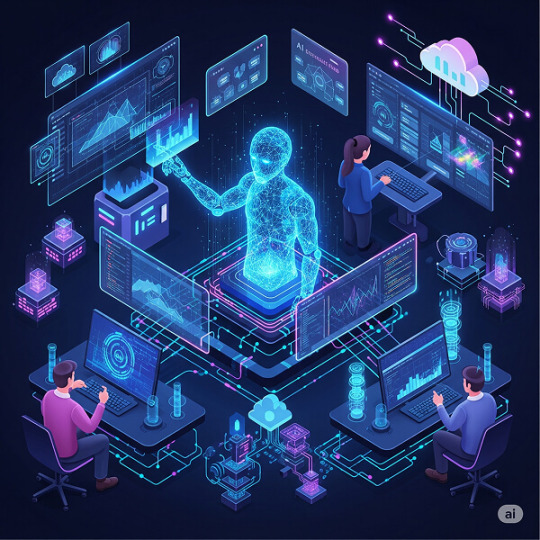
Planning & Design: AI platforms analyze historical data to forecast project timelines and resource allocation.
Risks: False assumptions from inaccurate historical data can mislead project planning.
Coding: AI-powered IDEs and assistants suggest code snippets, auto-complete functions, and generate boilerplate code.
Risks: AI chatbots may overlook edge cases or scalability concerns.
Testing: Automated test case generation using AI ensures broader coverage in less time.
Risks: AI might miss human-centric use cases and unique behavioral scenarios.
Deployment & Maintenance: AI helps predict failures and automates software patching using computer vision and ML.
Risks:False positives or missed anomalies in logs could lead to outages.
The Role of AI in Retail, RPA, and Computer Vision

Industries such as retail and manufacturing are increasingly integrating AI.
In Retail: AI is used for chatbots, customer data analytics, and inventory management tools, enhancing personalized shopping experiences through machine learning and deep learning.
Risk: Over-personalization and surveillance-like tracking raise ethical concerns.
In RPA: Robotic Process Automation tools simplify repetitive back-end tasks. AI adds decision-making capabilities to RPA.
Risk: Errors in automation can lead to large-scale operational failures.
In Computer Vision: AI is applied in image classification, facial recognition, and quality control.
Risk: Misclassification or identity-related issues could lead to regulatory scrutiny.
Navigating the Risks: Best Practices
To safely harness the power of AI in development, businesses should adopt strategic measures, such as establishing AI ethics policies and defining acceptable use guidelines.
By understanding the transformative power of AI and proactively addressing its risks, organizations can better position themselves for a successful future in software development. Key Recommendations:
Audit and regularly update AI datasets to avoid bias.
Use explainable AI models where possible.
Train developers on AI tools while reinforcing core engineering skills.
Ensure AI integrations comply with data protection and security standards.
Final Thoughts: Embracing AI While Staying Secure
AI, ML, and DL have revolutionized software development, enabling automation, accuracy, and innovation. However, they bring complex risks that require careful management. Organizations must adopt a balanced approach—leveraging the strengths of AI platforms like GPT chat AI, open chat AI, and RPA tools while maintaining strict oversight.
As we move forward, embracing AI in a responsible and informed manner is critical. From enterprise AI adoption to computer vision applications, businesses that align technological growth with ethical and secure practices will lead the future of development.
#artificial intelligence chat#ai and software development#free ai chat bot#machine learning deep learning artificial intelligence#rpa#ai talking#artificial intelligence machine learning and deep learning#artificial intelligence deep learning#ai chat gpt#chat ai online#best ai chat#ai ml dl#ai chat online#ai chat bot online#machine learning and deep learning#deep learning institute nvidia#open chat ai#google chat bot#chat bot gpt#artificial neural network in machine learning#openai chat bot#google ai chat#ai deep learning#artificial neural network machine learning#ai gpt chat#chat ai free#ai chat online free#ai and deep learning#software development#gpt chat ai
0 notes
Text
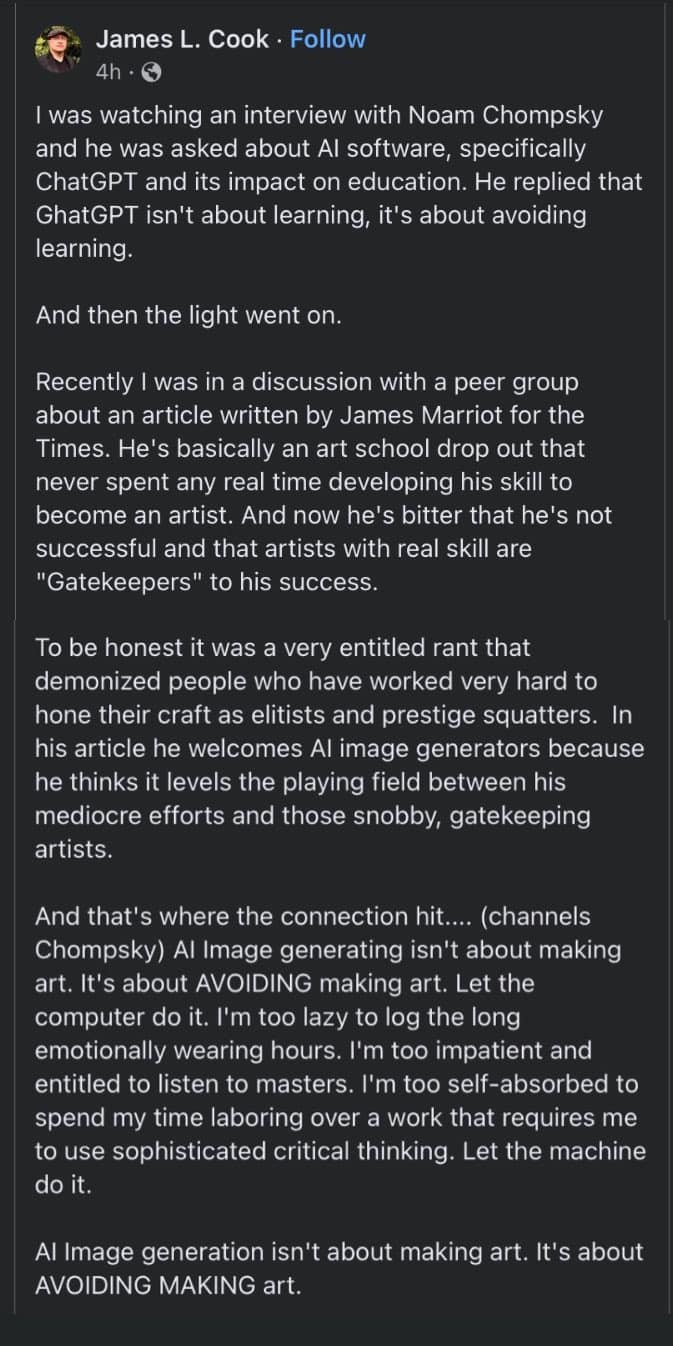
Image description from the notes by @summery-captain:
"A post by James L. Cook, reading: "I was watching an interview with Noam Chompsky and he was asked about AI software, specifically Chat GPT and its impact on education. He replied that Chat GPT isn't about learning, it's about avoiding learning.
And then the light went on.
Recently I was in discussion with a peer group about an article written by James Marriot for the Times. He's basically an art school drop out that never spent any real time developing his skill to become an artist. And now he's bitter that he's not successful and that artists with real skill are 'gatekeepers' to his success.
To be honest it was a very entitled rant that demonized people who have worked very hard to hone their craft as elitists and prestige squatters. In his article he welcomes AI generators because he thinks it levels the playing field between his mediocre efforts and those snobby, gatekeeping artists.
And that's where the connection hit... (channels Chompsky) AI image generating isn't about making art. It is about AVOIDING making art. Let the computer do it. I'm too lazy to log the long emotionally wearing hours. I'm too impatient to listen to masters. I'm too self-absorbed to spend my time laboring over a work that requires me to use sophisticated critical thinking. Let the machine do it.
AI imagine generation isn't about making art. It's about AVOIDING MAKING art." End of imagine description
59K notes
·
View notes
Text
The Role of Augmented Reality Websites in E-Commerce
Shopping online has always offered convenience, but it often lacks the tactile experience of physical stores. This is where an augmented reality website shines. AR bridges this gap by allowing customers to interact with products virtually.
Reducing Buyer Uncertainty
One of the main challenges in online shopping is uncertainty—customers often hesitate because they can't fully assess the product. Features like virtual try-ons, 3D product previews, and real-world placement tools eliminate this doubt.
With an augmented reality website, users can rotate, zoom, and customize products before making a purchase. This interactive experience boosts buyer confidence, reduces returns, and increases satisfaction. Customers leave the site feeling assured that they’ve made the right choice, which is invaluable for retailers.
Key Features of AR Ecommerce Platforms

Virtual Product Interactions
AR ecommerce platforms enable shoppers to engage with products like never before. Features such as product rotation, scaling, and color customization give users control over their experience. For instance, a customer shopping for a handbag can see how it looks from all angles, change its color, or adjust its size to better understand its fit.
These tools make ar ecommerce platforms not just functional but enjoyable, turning the shopping journey into an interactive experience that customers remember and return to.
Interactive Showrooms
Interactive showrooms are a standout feature of augmented reality website solutions. They let customers visualize products in their own space, whether it’s a couch in their living room or a painting on their wall.
These virtual showrooms are particularly valuable for industries like home decor, fashion, and electronics. They replicate the experience of walking through a physical store, offering a convenient and immersive way to explore products before making a decision.
Role of Prompt Engineering in Augmented Reality Websites
Optimizing User Queries for AR Performance
AI-driven Prompt Engineering is at the heart of enhancing AR experiences on websites. It ensures that users’ queries—like “show me how this looks in a small room” or “can I see it in red?”—are processed accurately and instantly.
By optimizing how these prompts are understood and executed, augmented reality website platforms can deliver faster, more precise results. This seamless interaction keeps users engaged and encourages them to explore more.
Driving Personalization Through Prompt-Based Suggestions
Prompt Engineering also plays a critical role in personalizing the AR experience. By analyzing user preferences and behavior, AI-driven prompts suggest relevant products and configurations. For example, if a user frequently views minimalist furniture, the system can recommend similar designs and allow them to visualize how they fit into their space.
This level of personalization not only enhances the shopping journey but also drives sales. Shoppers feel valued and understood, making them more likely to trust and engage with the ar ecommerce platform.
Benefits of AR Ecommerce for Customers and Retailers

Improved User Engagement
An augmented reality website transforms passive browsing into active exploration. By allowing users to interact with products through AR features like 3D views and virtual try-ons, customers stay engaged longer.
When customers spend more time on your platform, they’re more likely to explore additional products and make purchases. This increased interaction not only enhances the shopping experience but also leads to higher conversions, making ar ecommerce a win-win for both customers and retailers.
Lower Return Rates
Returns are a common challenge in e-commerce, often due to customers receiving items that don’t meet their expectations. AR features help solve this problem by providing detailed product visualizations.
For instance, customers can see how a sofa fits in their living room or how a pair of shoes looks on their feet before buying. These tools give shoppers the confidence to make better-informed decisions, which translates into fewer returns and higher customer satisfaction. Retailers save on logistics costs, making AR an invaluable addition to their platforms.
How Rotapix Delivers Cutting-Edge AR Ecommerce Solutions
Custom Augmented Reality Website Development
At Rotapix, every augmented reality website is built to meet the unique needs of the retailer. From virtual fitting rooms for fashion brands to interactive showrooms for furniture stores, Rotapix tailors AR features to align with specific business goals.
These custom solutions enhance user experiences, ensuring that your platform stands out in a competitive e-commerce landscape. Rotapix combines creativity and technical expertise to deliver impactful ar ecommerce platforms that leave a lasting impression.
Integrating Prompt Engineering for Enhanced Performance
Rotapix takes AR a step further by integrating advanced Prompt Engineering. AI-powered prompts allow platforms to offer instant, relevant recommendations based on user behavior. For example, if a shopper is browsing minimalist chairs, the system can suggest matching decor items or alternative styles.
This seamless blend of AI and AR creates a personalized, interactive shopping journey that keeps users engaged and drives higher sales. By leveraging both technologies, Rotapix ensures an optimized and memorable experience for every visitor.
Future Trends in AR Ecommerce Websites

AR and AI Integration
The future of ar ecommerce lies in the deeper integration of AR and AI technologies. With advancements in Prompt Engineering, platforms will become even more intuitive, offering users highly personalized suggestions and immersive experiences.
Imagine a website that not only shows you how a product fits into your space but also predicts your preferences based on past behavior. This level of precision is where the e-commerce industry is heading, and Rotapix is at the forefront of this transformation.
Expanding Accessibility and Usability
Rotapix is committed to making AR technology accessible to all users, regardless of their device or technical expertise. Their augmented reality website solutions are designed to work seamlessly across smartphones, tablets, and desktops.
By prioritizing usability, Rotapix ensures that AR features are easy to navigate and engaging for all demographics. This focus on inclusivity not only broadens the customer base but also sets a high standard for the future of e-commerce platforms.
0 notes
Text


starting with her since this particular model gets some of the most likes and favorites. I am advancing my project for consistency AI generation and even speech! making a more stripped apart version of gpt and maybe even using API. this will create pretty much cosplay on request! and maybe other fan service.

her being able to do her own video content is also another goal of mine but something I will have to put on the back burner for now. also I am in need of guinea pigs so if anyone wants to see a cosplay model brought to life I emphasize cosplay because most AI bans outright NSFW. feel free to drop links below.
#ai#aicosplay#ai community#ai artwork#robotics#coding#developer#gpt#ai generated#robots#cosplayers#chat gpt#gptgirlfriend#synthetic human
1 note
·
View note
Text
"Automate Customer Support with ChatGPT Integration Services"

"Experience the power of AI in customer support with our tailored ChatGPT integration. From automating responses to delivering personalized interactions, our service ensures you stay ahead in delivering top-notch customer experiences."
0 notes
Text

How does ChatGPT work?
Imagine having a conversation with a chatbot that feels almost human. That’s exactly what OpenAI ChatGPT brings to the table. The remarkable technology of Generative Pre-trained Transformer (GPT) powers it.
ChatGPT utilizes Natural Language Processing (NLP) techniques. These help it to learn from past conversations and generate response options.
It is trained on massive amounts of human interaction data. This results in an AI that can understand and have conversations like humans. It was released as a free research preview/prototype in November 2022. It is powered by a machine learning model called GPT-3, developed by OpenAI.
Click here to read more-
#artificial intelligence chat gpt#chat ai#artificial intelligence openai#openai chatgpt#ai chat gpt#ai chatgpt#chat gpt ai#ai gpt#open ai chatbot#blog#nitorinfotech#software development#software services#software engineering#artificial intelligence#ascendion
0 notes